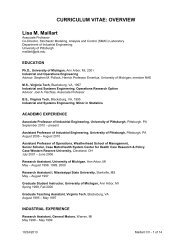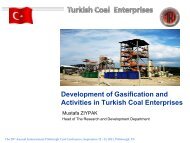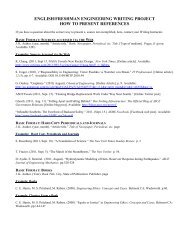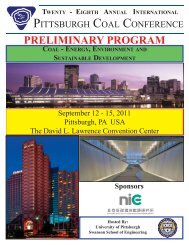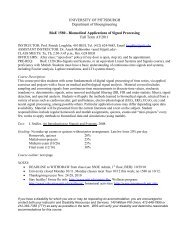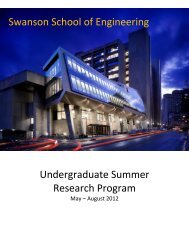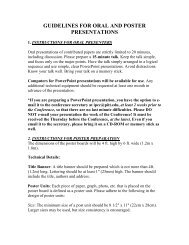Abstract Booklet 2006 - Swanson School of Engineering - University ...
Abstract Booklet 2006 - Swanson School of Engineering - University ...
Abstract Booklet 2006 - Swanson School of Engineering - University ...
You also want an ePaper? Increase the reach of your titles
YUMPU automatically turns print PDFs into web optimized ePapers that Google loves.
28-5<br />
A Kinetic Approach to Catalytic Oxidation <strong>of</strong> Mercury in Flue Gas<br />
Evan J. Granite, Albert A. Presto, Henry W. Pennline, Andy Karash, William J.<br />
O’Dowd, Richard A. Hargis, DOE/NETL, USA<br />
Several materials have been examined as catalysts for the oxidation <strong>of</strong> mercury in a<br />
bench-scale packed-bed reactor located at NETL. The catalysts examined include<br />
activated carbon, Thief carbons, precious metals, fly ash, and halogen compounds.<br />
Slipstreams <strong>of</strong> flue gas generated by the NETL 500-lb/hr pilot-scale combustion<br />
facility were contacted with the catalysts. An on-line continuous emissions monitor<br />
(CEM) was employed to measure elemental and oxidized mercury entering and exiting<br />
the bed. The apparent activation energy and reaction order for mercury were<br />
determined for several <strong>of</strong> the catalysts. Future research on catalyst materials will be<br />
conducted in a bench-scale packed-bed reactor employing both simulated and real flue<br />
gas streams generated on-site at NETL. The work presented in this manuscript was<br />
also accepted for publication in Energy & Fuels.<br />
SESSION 29<br />
GAS TURBINES AND FUEL CELLS FOR SYNTHESIS GAS AND<br />
HYDROGEN APPLICATIONS – 1<br />
29-1<br />
Coal IGCC Turbine Technology Improvements for Carbon Free Fuels<br />
Ashok Anand, Benjamin Mancuso, Kevin Collins, Greg Wotzak, GE Energy, USA<br />
Reduction <strong>of</strong> carbon dioxide from Coal-based IGCC Power Plants is rapidly gaining<br />
increased interest in future installations. Studies have shown that IGCC technology is<br />
able to capture and remove carbon dioxide at lower economic penalty as compared to<br />
conventional pulverized coal fired steam plants. Further improvements in IGCC power<br />
plants with carbon capture, is possible though the development <strong>of</strong> specific gas turbine<br />
cycle designs that increase plant efficiency at reduced costs and emissions. The<br />
performance influence <strong>of</strong> a typical heavy-duty gas turbine’s cycle parameters on IGCC<br />
plant with carbon capture is presented. An optimization analysis method is described,<br />
which can be successfully applied to select a gas turbine cycle design to achieve plant<br />
level performance goals.<br />
29-2<br />
Advanced Hydrogen Turbine Development<br />
Ed Bancalari, Ihor S. Diakunchak, Pedy Chan, Siemens Power Generation, Inc., USA<br />
The Advanced Hydrogen Turbine Development Project objective is to design and develop a<br />
fuel flexible (coal derived hydrogen or syngas) advanced gas turbine for Integrated<br />
Gasification Combined Cycle (IGCC) and FutureGen type applications that meets the U.S.<br />
Department <strong>of</strong> Energy (DOE) turbine performance goals. The overall DOE Advanced<br />
Power System goal is to conduct the Research and Development necessary to produce CO 2<br />
sequestration ready coal-based IGCC power systems with high efficiency (45-50% [HHV]),<br />
near zero emissions (< 2 ppm NO x @ 15% O 2 ) and competitive plant capital cost (<<br />
$1000/kW). DOE has awarded Siemens Power Generation a contract for Phases 1 and 2<br />
development work. Phase 1 activities will include identification <strong>of</strong> advanced technologies<br />
required to achieve the Project goals, detailed Research & Development Implementation<br />
Plan preparation and conceptual designs for the new gas turbine components. In Phase 2, the<br />
identified concepts/technologies will be down selected and a detailed design <strong>of</strong> the gas<br />
turbine will be completed. Phase 3, which has not yet been awarded, will involve the<br />
advanced gas turbine and IGCC plant construction and validation/demonstration testing. The<br />
end objective is to validate the advanced gas turbine technology by 2015. The starting point<br />
for this development effort is the SGT6-6000G gas turbine. This gas turbine will be adapted<br />
for operation on coal and biomass derived hydrogen and syngas fuels, as well as natural gas,<br />
while achieving high performance levels and reduced capital costs. This paper describes<br />
Phase 1 activities and accomplishments in the first 9 months since the program was initiated.<br />
29-3<br />
Benefits to IGCC Gas Turbines <strong>of</strong> Advanced Vortex Combustion<br />
Robert Steele, Pete Baldwin, Ramgen Power Systems, USA<br />
Ramgen Power Systems is developing an Advanced Vortex Combustion (AVC) technology<br />
for combustion <strong>of</strong> hydrogen-based fuels which shows tremendous potential for increased<br />
energy efficiency and improved asset utilization. The fundamentals <strong>of</strong> the technology and<br />
the potential advantages <strong>of</strong> incorporating the AVC approach into an IGCC gas turbine will<br />
be presented. The AVC technology can be applied to the efficient and cost-effective<br />
combustion <strong>of</strong> hydrogen-based fuels with sub-3 ppmv NO x emissions while maintaining or<br />
extending simple cycle efficiencies. The AVC technology has the potential for improved<br />
turbine efficiency, lower NO x<br />
emissions, greater flame stability, high flame speed flexibility, increased durability, and<br />
reduced manufacturing costs. This approach can play an important role in the advancement<br />
<strong>of</strong> future Integrated Gasification Combined Cycle (IGCC) power plants that will require<br />
hydrogen-enriched fuel burning gas turbines. The flame speed <strong>of</strong> hydrogen-air mixture is six<br />
times higher than a natural gas-air mixture. Conventional swirl-based combustion systems<br />
25<br />
need customized modifications in order to manage the potential for flame flashback. The<br />
unique insensitivity <strong>of</strong> the AVC approach to high through-put velocities will reduce<br />
hardware modifications and accommodate the extremely fast burning hydrogen-based fuels.<br />
In addition, Ramgen’s AVC technology is cross-cutting and capable <strong>of</strong> delivering benefits to<br />
many <strong>of</strong> the technical areas <strong>of</strong> concern in zero-emissions combustor-based facilities<br />
including the oxy-fuel Rankine cycle system.<br />
29-4<br />
Catalytic Combustion for Ultra-Low NO x Hydrogen Turbines<br />
Benjamin Baird, S. Etemad, Sandeep Alvandi, William C. Pfefferle, H. Karim,<br />
Precision Combustion, Inc., USA<br />
Kenneth O. Smith, W. Nazeer, Solar Turbines, Inc., USA<br />
Precision Combustion, Inc. (PCI), under sponsorship from the U.S. Department <strong>of</strong><br />
Energy, is further developing it’s Rich Catalytic Lean-burn (RCL®) combustion<br />
system for hydrogen fuels. Rich catalytic operation has successfully demonstrated low<br />
single digit ppm NO x and the ability to burn hydrogen fuels in 9 atmosphere subscale<br />
tests. The test data show the potential <strong>of</strong> using rich catalytic combustion for low single<br />
digit emissions. Areas <strong>of</strong> further work to commercialize this technology has been<br />
identified. PCI, in collaboration with Solar Turbines Incorporated and other gas turbine<br />
manufacturers, has a 39 month DOE Fossil Energy Turbine Technology R&D program<br />
to develop and demonstrate a low emission rich catalytic combustion system for fuel<br />
flexible ultra-low NO x megawatt-scale gas turbines that can utilize hydrogen fuel,<br />
facilitate high efficiency operation, and be installed or retr<strong>of</strong>itted into existing turbines.<br />
This paper presents the status <strong>of</strong> the rich catalytic application from the combustion<br />
point <strong>of</strong> view for MW size engine application.<br />
29-5<br />
Development <strong>of</strong> Turbo Machinery for a Zero CO 2 Emissions Oxy-Fuel Cycle<br />
Mohan A. Hebber, Shiv Dinkar, Juan Pablo Gutierrez, Siemens Power Generation, Inc.<br />
Jim Downs, Florida Turbine Technologies, Inc., USA<br />
In 2005 the U.S. Department <strong>of</strong> Energy-National Energy Technology Laboratory (DOE-<br />
NETL) awarded a program to Siemens Power Generation (SPG), Inc. to develop turbo<br />
machinery powered by oxy-fuel combustion, which generates near zero emissions and<br />
provides for economical CO 2 capture capability. (The combustor for this oxy-fuel cycle is to<br />
be developed separately by Clean Energy Systems (CES), Inc. <strong>of</strong> Rancho Cordova,<br />
California.). The new working fluid (a mixture <strong>of</strong> CO 2 and steam) and the desire to<br />
maximize the plant cycle efficiency pose numerous technical challenges not only in<br />
developing the turbine designs and consideration <strong>of</strong> material systems, but also in the<br />
selection <strong>of</strong> a plant cycle. The calculation <strong>of</strong> auxiliary loads for Fuel Processing Plant<br />
(gasifier), Air Separation Unit (ASU), O 2 compression, CO 2 compression, limitations on<br />
metal temperatures and other boundary conditions – all posed difficulties in arriving at<br />
cycles for further consideration. Any turbine design that depends on boundary conditions<br />
higher than the current state-<strong>of</strong>-the-art poses special challenges in the selection <strong>of</strong> materials.<br />
Initial studies indicate that materials in the turbine for the “topping” cycle may have to<br />
tolerate a Turbine Inlet Temperature (TIT) well in excess <strong>of</strong> 1500°C with CO 2 and H 2 O as<br />
working fluid. With regards to the steam turbine in the “bottoming” cycle, major challenges<br />
are anticipated in selecting materials for the turbine casing, rotor, blading, valves, sealing and<br />
bolting. Other challenges include innovative cooling techniques including, but not limited to,<br />
the development <strong>of</strong> serpentine cooling paths; development <strong>of</strong> start-up procedures and<br />
algorithms for controls and life consumption. The paper describes approaches planned to<br />
overcome the technical challenges and develop turbine designs that meet the overall<br />
objectives <strong>of</strong> the program including the efficiency goals. An overall time line is also<br />
identified for key milestones.<br />
SESSION 30<br />
GLOBAL CLIMATE CHANGE: CO 2 CAPTURE – 2:<br />
MEMBRANES AND SOLID SORBENTS<br />
30-1<br />
Experimental Investigation <strong>of</strong> a Molecular Gate Membrane for<br />
Separation <strong>of</strong> Carbon Dioxide for Flue Gas<br />
James H<strong>of</strong>fman, Henry W. Pennline, DOE/NETL, USA<br />
Shingo Kazama, Teruhiko Kai, Takayuki Kouketsu, Shigetoshi Matsui, Koichi<br />
Yamada, RITE, JAPAN<br />
Commercial-sized modules <strong>of</strong> the PAMAM dendrimer composite membrane with high<br />
CO 2 /N 2 selectivity and CO 2 permeance were developed according to the In-situ Modification<br />
(IM) method. This method utilizes the interfacial precipitation <strong>of</strong> membrane materials on the<br />
surface <strong>of</strong> porous, commercially available polysulfone (PSF) ultrafiltration hollow fiber<br />
membrane substrates. A thin layer <strong>of</strong> amphiphilic chitosan, which has a potential affinity for<br />
both hydrophobic PSF substrates and hydrophilic PAMAM dendrimers, was employed as a<br />
gutter layer directly beneath the inner surface <strong>of</strong> the substrate by the IM method. PAMAM<br />
dendrimers were then impregnated into the chitosan gutter layer to form a hybrid active layer<br />
for CO 2 separation. Permeation experiments <strong>of</strong> the PAMAM dendrimer composite<br />
membrane were carried out using a humidified mixed CO 2 / N 2 feed gas at a pressure



